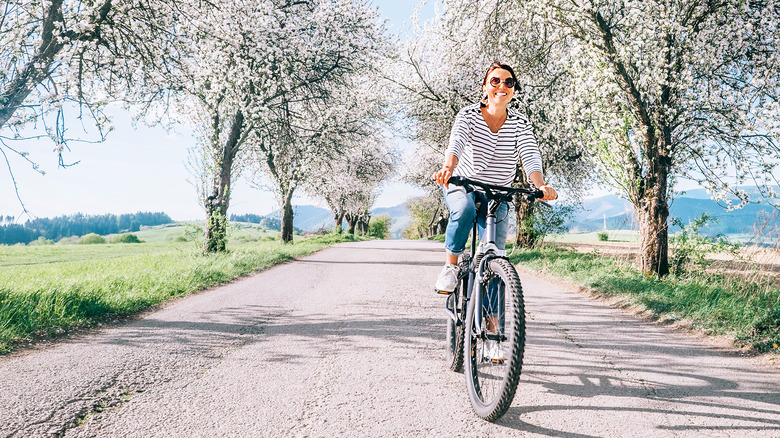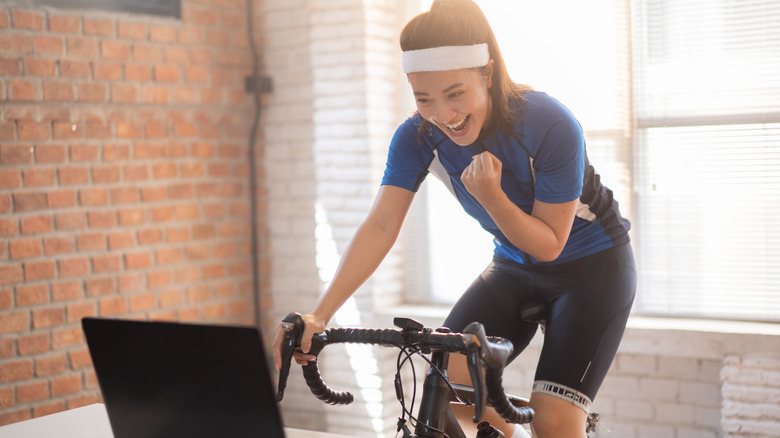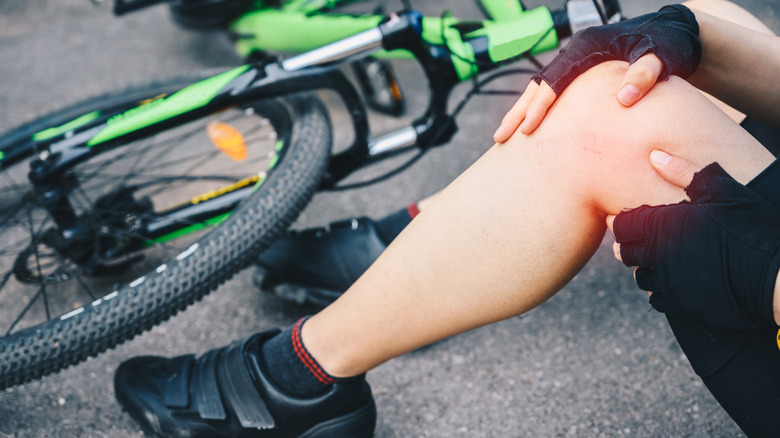Here's What Cycling Really Does To Your Knees
Do you love cycling, but are afraid of its impact on the knees? For starters, you should know that cycling is a low-impact activity and puts less stress on the joints than other forms of exercise. Moreover, it can improve your range of motion and reduce joint pain (via World Medical Hospital). This fun yet challenging activity can improve joint flexibility, muscle function, even heart health, and boost your overall fitness.
The downside of bike riding is the repetitive motion of the legs that can lead to overuse injuries, including wear and tear of the knee joint. "Cycling is a highly repetitive sport, with a rider averaging about 5,000 pedal strokes per hour," notes The Body Mechanic, a physiotherapy practice based in Australia. Over time, prolonged riding can cause tight quadriceps and hamstrings, which can restrict range of motion around the knee and further increase your risk of injury.
A 2017 study published in the Journal of Community and Family Medicine found that about 27% of amateur cyclists and 16% of professional cyclists experienced mild to moderate knee pain. Surprisingly, their symptoms had less to do with time in the saddle or distance ridden than with other factors.
Cycling can strengthen your knees and improve joint function
Done correctly, riding a bike is one of the best things you can do for your knees, even if you have an existing condition that affects joint health. Clinical research published in The Permanente Journal suggests that cycling can reduce pressure on the joints and improve knee osteoarthritis symptoms. This activity may also relieve pain and enhance physical function in hip osteoarthritis patients (per SAGE Open Medicine).
Cycling does even more good than reducing the stress on your joints. Pedaling also increases the range of motion of the hip, knee, and ankle joint, according to a 2021 study featured in BMC Musculoskeletal Disorders. As a result, it can speed up recovery from injuries and improve your overall fitness. Plus, it strengthens the quadriceps, hamstrings, and other muscles around the knees, leading to increased knee stability.
Both outdoor and indoor cycling can strengthen your leg muscles and knees. Riding uphill outdoors — or adjusting the resistance knob on a stationary bike to mimic an uphill climb — makes the quadriceps and calves work harder than on a flat surface, biking expert Melissa Sebastian told Shape. Pushing down on the pedal uses all the muscles in your quads and calves, she said, and "then as you pull back and up, your hamstring glutes, and shin muscles get activated." Legs work less pedaling downhill, when momentum more than leg rotation moves you forward.
What causes cycling knee pain?
Despite its potential benefits, cycling can do harm to your knees and other joints. The repetitive motion of pedaling may lead to overuse injuries (via Physiopedia). Pain at the front of the knee may indicate damage to the meniscus or cartilage that comes with repetitive movement, osteopath Alice Monger-Godfrey told Cycling Weekly. "If the knee is held in [the] wrong position for a long time, it can really irritate the tendons where the quads attach at the front, just below the knee cap," she said. "You can get quite severe pain there where the tendon gets inflamed, and this can spread around the knee."
Cyclists may also experience posterior knee pain, typically due to the saddle being set too high and causing the hamstring muscles to overextend. Low handlebars or poor cleat positioning could cause pain around the inner or outer side of the knee. And if cyclists don't maintain core strength, this can be a set up for knee problems, as well.
While there's no surefire way for cyclists to prevent knee pain, proper bike fit and cleat positioning can mitigate the risk of injury. Moreover, a strong core is "paramount for everything. A strong core gives you a stable base," Monger-Godfrey says. Pilates and exercises such as lunges, leg extensions, and Swiss ball bridges for building core strength, plus foam rolling and stretching for recovery, according to Monger-Godfrey, can help keep you in the saddle, on the road and pain free.



